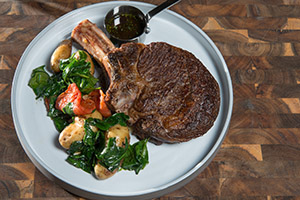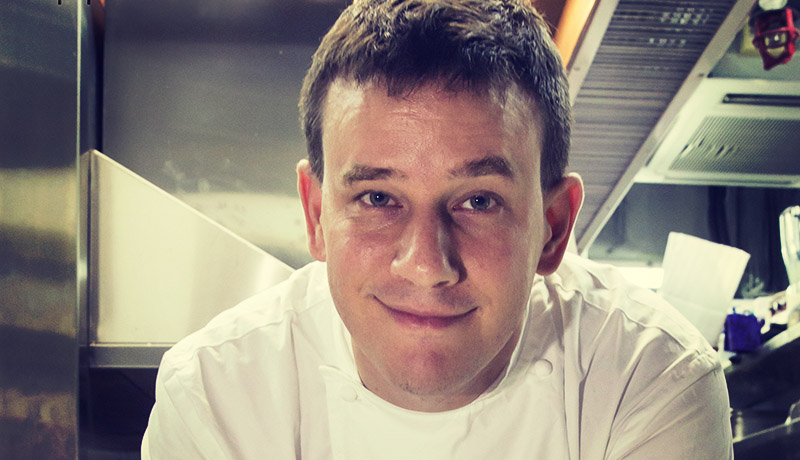

Chef Philippe Orrico
Photo Courtesy of Upper Bistro
Chef Philippe Orrico, born in the tiny French island of Réunion, hit his stride after moving to Hong Kong in 2006. He originally came to the city as an apprentice to decorated Pierre Gagnaire at the Forbes Travel Guide Five-Star Pierre at Five-Star Mandarin Oriental, Hong Kong. He went on to helm St. George at Hullett House hotel.
Upon striking out solo in 2013, Orrico launched Nomad Dining group, which included three independent venues — Upper Modern Bistro in Sheung Wan, On Dining Kitchen & Lounge in Central and Picnic on Forbes in Kennedy Town. Orrico tells Forbes Travel Guide more about his concepts and how he plans on introducing Hong Kong to even more French-fusion cuisine.
How did you make your way to Hong Kong?
When I left my little island of Réunion, I was 19. Now I’m 41, so it’s been 20 years. At first, I was traveling a little bit and finally I arrived in a kitchen. At the time I was thinking it was bad luck, but now I think it’s nothing but a good thing. While I was doing that, I started to work in a few good restaurants in Bordeaux, London and Paris. Eventually, I came to Hong Kong in 2006 to open a new restaurant under chef Pierre Gagnaire in the Mandarin Oriental hotel.

Picnic Basket, Photo Courtesy of Picnic by Philippe Orrico
How does your background affect your recipes?
Growing up in Réunion has influenced me a lot. It’s an island with five major communities — Muslim, Indian, Chinese, European, Creole — and so I grew up with all these foods and cultures. Hong Kong is similar in some ways. Something that’s interesting in Hong Kong is the relationship between east, west, modern, classic — Hong Kong can be all of these things at one time. It’s all about balance.
I’m very east-west in the way I cook. When I came here, I was really in my element because of the Chinese food and the mix of cultures and all. My menus sound simple, but if you were to hear everything inside, you might think it is fusion cuisine or something. But, for me, it is all familiar and normal to combine seemingly incongruent ingredients.
Which ingredients do you reach for most often?
I cook with eggs all the time and use them in many, many ways. They’re all over my menus. I was one of the first to introduce the 63-degree egg in Hong Kong nine years ago. Now you see them everywhere, but I was one of the first to use it. I wouldn’t say I was the first to invent it because that’s impossible to say. Maybe people were doing it already, but I didn’t know. The texture is very interesting because the white is cooked and the yolk texture is warm, and it’s just a beautiful dish.
How’d you come up with your first venture, Upper Modern Bistro?
I wanted to open a bistro. Why a bistro? Because I think it offers the most freedom — the guests will accept a bit of everything, from high-end to casual food.
The restaurant is contemporary and I wanted it to fit our epoch, and what is it about our epoch? People are always moving and everyone is international — they eat sushi in the morning, pizza at lunchtime and French food at dinner.
What’s the idea behind On Dining Kitchen & Lounge?
The idea of On was to let these four people shine at what they do: I’m working with Jeremy Evrard (the former restaurant director at Five-Star Four Seasons Hotel Hong Kong) on the floor, sommelier Nicolas Deneux (former head sommelier at Four-Star Grand Hyatt Hong Kong) and mixologist Giancarlo Mancino (former bar consultant of 8 1/2 Otto e Mezzo BOMBANA Shanghai).
Being in Central, we have to be a bit more high-end, but we didn’t want to have purely fine dining because we are all coming from that from years and years. It was a moment to finally break away and create something more relaxed, more approachable.
Your latest is Picnic on Forbes in Kennedy Town. What’s the concept here?
Honestly, I might have had the idea for the café in my head even longer than the bistro. For me, a café is something very French — it’s social, it’s quick for a coffee or a drink with friends, or a bite of pasta.

Milk-Fed Veal Cutlets, Photo Courtesy of Picnic by Philippe Orrico
Typically in France, a café is something very social and welcoming. So, the idea is perfect for this calm, residential area of Kennedy Town. When we settled on the name, we then started playing with presentation, putting food in picnic baskets and jars for more personality.
Why should travelers take the time to explore Kennedy Town?
It’s good to see another part of Hong Kong. When you arrive, you see the busy Central area — all the bars and the energy. I think if someone wants to visit Hong Kong, they need to go to The Peak and see Central and Kowloon, of course, but it’s good to make time to explore quieter and cooler neighborhoods, like Sheung Wan and Kennedy Town, too.
Since you moved here nine years ago, how has the dining scene evolved?
I have seen a big wave of change in Hong Kong. When I first arrived, I would say that all of the great restaurants were in hotels. Step by step, restaurants and chefs started moving outside of hotels. Chefs like Umberto Bombana and Joël Robuchon led the way.
Hong Kong also started to absorb lots of concepts from London and New York. In the next few years, I think Hong Kong will start to push more of its own concepts outside to Asia, New York and London.
